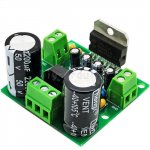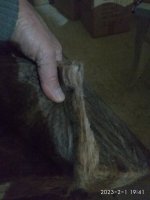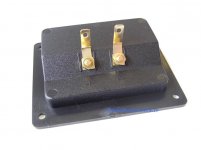For a first please (!) do not use an amp. Level matching is quite complicated and one mistake will blow your sound card. Which is especialy bad with a laptop. The "ARTA" measuring box has parts build in that prevent such mistakes, but the simple wire/ resistor jig is a potential sound card killer.
Only use the headphone out, you can not damage anything that way.
Results from high (with amp) and low level (only soundcard) measurements will be quite similar. If you have very large, high excursion sub woofer speaker, they may not move enough to give a typical result, but a "normal" speaker with good efficienty like yours will measure just fine with low level. Keep the noise level as low as possible while measuring, otherwise the speaker acts as a microphone and give erratic readings.
Later, when you have a measuring box or do SPL measurements, you should add an amp, but for now it is much better the simple and inexpensive way.
Only use the headphone out, you can not damage anything that way.
Results from high (with amp) and low level (only soundcard) measurements will be quite similar. If you have very large, high excursion sub woofer speaker, they may not move enough to give a typical result, but a "normal" speaker with good efficienty like yours will measure just fine with low level. Keep the noise level as low as possible while measuring, otherwise the speaker acts as a microphone and give erratic readings.
Later, when you have a measuring box or do SPL measurements, you should add an amp, but for now it is much better the simple and inexpensive way.
If you want an amp, later, consider building one your self from a cheap ebay module. For limited output level you can even run it on batteries, which has some advantages. A very nice one is a TDA7294 Amplifier Board, cheap from ebay (10€) or some other medium power AB chip amp with dual supply voltage.
Attachments
Im quite intrigued by this speaker. Ive found the x-over components @ Quint and the speakers @ https://www.costruireaudio.com/ but the horn isn't very well defined. It resembles a Celestion H1 9040P. But what is it and where do I find it?
Also, I was wondering if it was worth it to step up in cap quality, since Troels Gravesen is raving on about this... but the big ones are almost the same price as the speaker units - Ouch!! Thats a definetly no go. But would it make sence to add a small quality cross cap in parallel w. the 560 uF (making sure the combined capacity = 560 uF)? I seem to recall that this was a thing when I studied electronics engineering a fair while ago...
Also, I was wondering if it was worth it to step up in cap quality, since Troels Gravesen is raving on about this... but the big ones are almost the same price as the speaker units - Ouch!! Thats a definetly no go. But would it make sence to add a small quality cross cap in parallel w. the 560 uF (making sure the combined capacity = 560 uF)? I seem to recall that this was a thing when I studied electronics engineering a fair while ago...
Since speaker prices are quite low and so are profits, the dealers sell the same x-over components that were less than 10% of the system cost 25 years ago at about 10 times the price. Parts that have not evolved (why do enlighted people prefer vintige parts?) but are produced faster and cheaper than today. Industry prices have dropped to all time lows, only if it is "for Audio" they exploded.
Medium quality. Boutique parts can easily cost 500$ for a pair of 2-way's. These parts do not sound better, in most cases identical. If there is a sonic difference that does not have it's cause in value differences, they sound a little colored. Boutique believers think this difference is a better sound. May be worse as well.
Avoid electrolitc capacitors and coils with cores and you should get 98% of the possible quality. If, for example a tweeter seems too "sharp" no one will be able to tell the difference of a higher pre-resistor for 1$ from a 259$ capacitor.
What can change the sound is the way you connect parts. Soldering parts to each other can be audible, compared to the use of wires and clamps for inter connections. Even as the measured differences may be minimal.
Medium quality. Boutique parts can easily cost 500$ for a pair of 2-way's. These parts do not sound better, in most cases identical. If there is a sonic difference that does not have it's cause in value differences, they sound a little colored. Boutique believers think this difference is a better sound. May be worse as well.
Avoid electrolitc capacitors and coils with cores and you should get 98% of the possible quality. If, for example a tweeter seems too "sharp" no one will be able to tell the difference of a higher pre-resistor for 1$ from a 259$ capacitor.
What can change the sound is the way you connect parts. Soldering parts to each other can be audible, compared to the use of wires and clamps for inter connections. Even as the measured differences may be minimal.
In stock here.https://www.banzaimusic.com/celestion-h1-9040p.htmlIm quite intrigued by this speaker. Ive found the x-over components @ Quint and the speakers @ https://www.costruireaudio.com/ but the horn isn't very well defined. It resembles a Celestion H1 9040P. But what is it and where do I find it?
Also, I was wondering if it was worth it to step up in cap quality, since Troels Gravesen is raving on about this... but the big ones are almost the same price as the speaker units - Ouch!! Thats a definetly no go. But would it make sence to add a small quality cross cap in parallel w. the 560 uF (making sure the combined capacity = 560 uF)? I seem to recall that this was a thing when I studied electronics engineering a fair while ago...
I bought mine from here but not in stock now.https://www.tubeampdoctor.com/en/celestion-h1-9040p-horn/plastic-90x40-t5359
Last edited:
Thank you Thimios!
My question was regarding the horn that Rese66 ended up using. In his box drawing the cut out for the horn is 166cm x 260cm. The Celestion horn is smaller requirering Cut-out diameter: 115mm x 250mm. I would expect the x-over to be uptimized for this horn and not the Celestion?
And TY fo rthe reply Turbo. Read a bit on Audiosciencereview regarding CAPs. It seems there is a difference, but its so small that it makes no difference in practice
My question was regarding the horn that Rese66 ended up using. In his box drawing the cut out for the horn is 166cm x 260cm. The Celestion horn is smaller requirering Cut-out diameter: 115mm x 250mm. I would expect the x-over to be uptimized for this horn and not the Celestion?
And TY fo rthe reply Turbo. Read a bit on Audiosciencereview regarding CAPs. It seems there is a difference, but its so small that it makes no difference in practice
I know this is off topic but couldn’t let it pass by without comment…….Soldering parts to each other can be audible, compared to the use of wires and clamps for inter connections. Even as the measured differences may be minimal.
A few years back I mentioned this very thing (sound differences after soldering a XO that was previously wire nut connected) but it was fully stomped down by the masses as hogwash, I know for sure it made a difference and to this day I no longer solder my XO’s
Sorry for the late reply. Nothing happened here for so long that I lost track of it.
About the damping material:
Rock wool is very good, a loose fill will do, leaving the area around the woofer clear. The walls I would still stick inside with something firmer material. Since the woofer also has to play midrange, there are also reflections on the walls inside.
As a horn I used the Celestion H1 9040-P. Celestion also specifies the opening like this:
Baffle cut-out: 165x260mm
The Monacor MRH-200 can also be used, because the contour is 1:1 the same as the Celestion horn. It is also slightly better made, but costs much much more.
Capacitors reach such high quality even in the cheap designs that you can no longer perceive differences with the ear. What can be useful is to get several capacitors and match them according to the smallest possible differences. This brings considerably more than to put the money in expensive components.
Unfortunately, in this hobby (see also cables, amplifiers, cd players, etc.) there are many more people who think they hear something than people who have actually checked it. In a blind test, no one would be able to hear differences without a doubt. Hearing is very easily influenced. It is enough to know that something has changed in the structure. Even if you don't change anything, but tell a test listener there is a difference, that person will hear a difference.
Likewise, the memory of our hearing is extremely short. After just a few seconds, it fades to the point that it is impossible to detect small differences.
But gold ears do not want to hear these facts. It's not a big deal, everyone can spend as much money as they like. I just have a problem with advising other people to invest more money than necessary.
About the damping material:
Rock wool is very good, a loose fill will do, leaving the area around the woofer clear. The walls I would still stick inside with something firmer material. Since the woofer also has to play midrange, there are also reflections on the walls inside.
As a horn I used the Celestion H1 9040-P. Celestion also specifies the opening like this:
Baffle cut-out: 165x260mm
The Monacor MRH-200 can also be used, because the contour is 1:1 the same as the Celestion horn. It is also slightly better made, but costs much much more.
Capacitors reach such high quality even in the cheap designs that you can no longer perceive differences with the ear. What can be useful is to get several capacitors and match them according to the smallest possible differences. This brings considerably more than to put the money in expensive components.
Unfortunately, in this hobby (see also cables, amplifiers, cd players, etc.) there are many more people who think they hear something than people who have actually checked it. In a blind test, no one would be able to hear differences without a doubt. Hearing is very easily influenced. It is enough to know that something has changed in the structure. Even if you don't change anything, but tell a test listener there is a difference, that person will hear a difference.
Likewise, the memory of our hearing is extremely short. After just a few seconds, it fades to the point that it is impossible to detect small differences.
But gold ears do not want to hear these facts. It's not a big deal, everyone can spend as much money as they like. I just have a problem with advising other people to invest more money than necessary.
"Rock wool is very good, a loose fill will do, leaving the area around the woofer clear."
Does that mean that the area behind woofer must be uncovered?
Mineral wool that I have is a little different than rock wool,is this still suitable?
Is this a good solution for a cabinet without reverberation? https://www.dbmelectronics.gr/ihos-autokinitou/monotika-autokiniton/standardplast-black-silver-shop-pack.
Does that mean that the area behind woofer must be uncovered?
Mineral wool that I have is a little different than rock wool,is this still suitable?
Is this a good solution for a cabinet without reverberation? https://www.dbmelectronics.gr/ihos-autokinitou/monotika-autokiniton/standardplast-black-silver-shop-pack.
Last edited:
Bollocks. Show the audibly significant measure differences.Soldering parts to each other can be audible, compared to the use of wires and clamps for inter connections. Even as the measured differences may be minimal.
This is material to reduce the vibration of the walls. You can certainly use this in addition, but it does not absorb sound.Is this a good solution for a cabinet without reverberation? https://www.dbmelectronics.gr/ihos-autokinitou/monotika-autokiniton/standardplast-black-silver-shop-pack.
The area behind the woofer should remain free so that it can "breathe".
I have found another picture here, how it looks with me:
This is how it looks behind the woofer, below it the cabinet is loosely filled.
You can use your mineral wool if it is not harmful, no problem.
Thanks Resse66,I will try to post some clear photos when I'm ready with damping.Mineral wool isn't harmful according to Knauf specs.
Thickness is about to 50mm.
From what I can see in your photo a thinner material used there?🤔
Please feel free to comment 🙂
I have an minidsp UMIK1 on hand now,but it is the first time that I will use this.
I don't know how this would be helpful for damping process.🤔
Thickness is about to 50mm.
From what I can see in your photo a thinner material used there?🤔
Please feel free to comment 🙂
I have an minidsp UMIK1 on hand now,but it is the first time that I will use this.
I don't know how this would be helpful for damping process.🤔
Attachments
Last edited:
My dear friend, what do you think about people that use solder containing a low percentage of silver and tell you it sounds better? That stuff is really expensive, you do not see it in the finished product and still it is considered highest end.
That may be b****.
In an advanced x-over you may find 2 dozends of connections between parts. The resistance summs up, well measureable, but not extreme.
Just take 10 short cut's of wire and connect them with some clamp. Then compare the resistance for the 10 soldered and a straigt wire of the same length. You do not need expensive gear to measure the resistance.
The usual connection terminals at the back of a speaker, with gilded screws, washers and a piece of thin metall as a solder point, have measurable resistance.
You can measure the difference if you solder, on the inside of the cabinet, directly to the bolt that clamps the speaker cable on the outside.
That may be b****.
In an advanced x-over you may find 2 dozends of connections between parts. The resistance summs up, well measureable, but not extreme.
Just take 10 short cut's of wire and connect them with some clamp. Then compare the resistance for the 10 soldered and a straigt wire of the same length. You do not need expensive gear to measure the resistance.
The usual connection terminals at the back of a speaker, with gilded screws, washers and a piece of thin metall as a solder point, have measurable resistance.
You can measure the difference if you solder, on the inside of the cabinet, directly to the bolt that clamps the speaker cable on the outside.
Attachments
Measuring with a microphone will not show much difference I fear. Details will get lost in room reflections and background noise.
As it has already been said, a resistance over frequency = impedance measurement will show you what effective damping does inside the speaker.
If you want to reduce resonating walls you need mass, best coupled to some visco elastic layer. The mass transfers energy to the soft layer, where it is converted into heat. In practice bitumen/ butyl with a layer of aluminum has shown to give well measurable results. If you go no compromise, take as reasonable layer of elastic glue and floor tiles. A lot of weight and loss of volume, but it works just fine.
There is an extremely over priced, steel ball filled panel called "Hawaphon". Glued to the inside it works quite well.
Felt or foam reduce reflections. Anyone has noticed how much a carpet floor changes the high frequncy reflection in an empty room, but it doesn't stop a resonating wall.
PS as most of these materials come from the construction of buildings (only with the price multiplyed by 20 for the DIYS speaker builder), a little search will show you data sheets of these materials, making discussions obsolete. A lot of the stuff sold is quite useless inside a speaker or sub woofer.
As it has already been said, a resistance over frequency = impedance measurement will show you what effective damping does inside the speaker.
If you want to reduce resonating walls you need mass, best coupled to some visco elastic layer. The mass transfers energy to the soft layer, where it is converted into heat. In practice bitumen/ butyl with a layer of aluminum has shown to give well measurable results. If you go no compromise, take as reasonable layer of elastic glue and floor tiles. A lot of weight and loss of volume, but it works just fine.
There is an extremely over priced, steel ball filled panel called "Hawaphon". Glued to the inside it works quite well.
Felt or foam reduce reflections. Anyone has noticed how much a carpet floor changes the high frequncy reflection in an empty room, but it doesn't stop a resonating wall.
PS as most of these materials come from the construction of buildings (only with the price multiplyed by 20 for the DIYS speaker builder), a little search will show you data sheets of these materials, making discussions obsolete. A lot of the stuff sold is quite useless inside a speaker or sub woofer.
Last edited:
Here is the schematic dated 1993I don't know what was in the SP2 crossover, only that is was 12 db/octave @ 1200 hz.
Crossover sp2 / sp4
Attachments
- Home
- Loudspeakers
- Multi-Way
- Asathor - a JBL 4367 Clone


